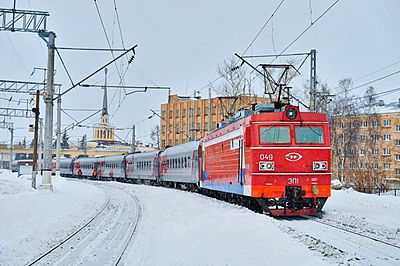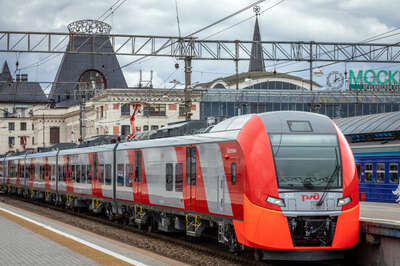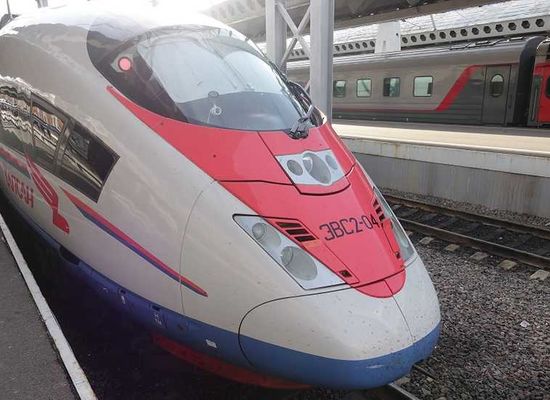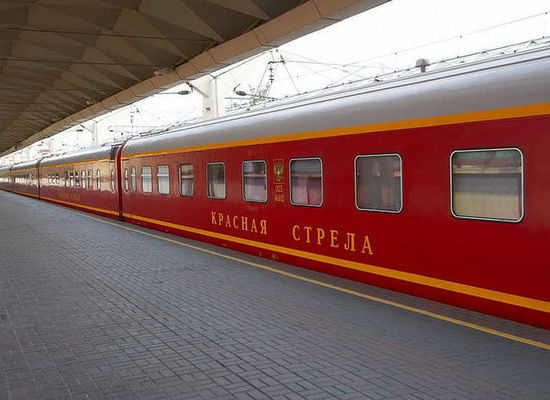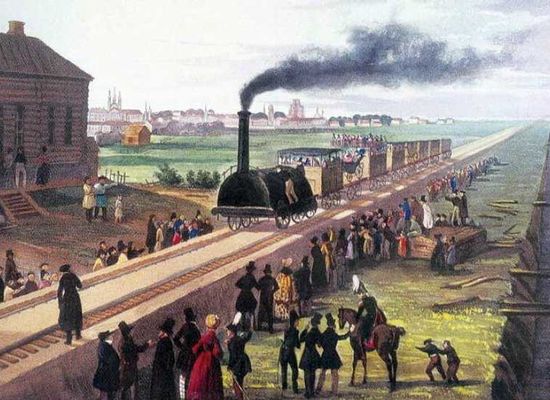St. Petersburg to Moscow Trains
Every St.Petersburg o Moscow train has a different character, read the descriptions to learn more
St. Petersburg to Moscow Train Route
Most St. Petersburg to Moscow trains travel without stops. Long-distance trains going to the south of Russia make up to 5-6 stops on the St. Petersburg to Moscow leg. The most popular stops are Tver and Bologoye.
On the St. Petersburg to Moscow route, there is a huge variety of trains to choose from. From 8-hour overnight trains to high-speed day trains, from the luxurious to the basic – you can always find a train that will suit your needs. The same trains run on the Moscow to St. Petersburg route. Electronic tickets are available on both routes, making your travel arrangements quick and easy.
St. Petersburg to Moscow Train Tickets
based on 1249 customer reviews
Frequently Asked Questions From Our Travelers
There are high speed and overnight trains available on this route. The fastest train called Sapsan takes 3.5 - 4 hours, regular overnight trains take 8 - 10 hours. There are several overnight trains offering different levels of comfort including the famous Grand Express and Red Arrow trains.
In St Petersburg, the Sapsan arrives and departs from Moscovsky Train Station, Nevsky Prospect 85, Metro Ploshad Vosstania. In Moscow, for all Sapsan trains running between St Petersburg and Moscow it is Leningradsky Train Station, located at Komsomolskaya Ploshad 3, Metro Komsomolskaya. Sapsan trains operating on the St Petersburg to Nizhny Novgorod route arrive and depart from Kursky Train Station, Zemlyanoi Val, 29, Metro Kurskaya.
Each 2nd and 3rd class passenger is allowed to bring up to 36 kg of hand luggage. 1st class passengers can carry up to 50 kg. The sum of the hand luggage's three dimensions should not exceed 180 cm. Children under 4 travelling on a free ticket (without a separate seat) are not granted a separate piece of luggage.
In general, there is no WiFi on Russian trains except for the Sapsan train traveling between St. Petersburg and Moscow.
Though the price and time on board is almost the same when you travel by air or by train, traveling by a high speed Sapsan train is considered to be the most convenient and fastest way to travel from St Petersburg to Moscow. Train stations in both cities are in the city center so the travel time is significantly shorter when compared to traveling by plane which includes airport check-in and traveling to and from the airport. Another advantage to the train is that passengers can bring up to 36 kg of hand luggage without paying anything extra. Sapsan seats are much more comfortable than airplane seats and you can also enjoy a nice meal at a reasonable price on board.
Testimonials
“
Great website to book Russian trains
I was traveling from SPB to MOW on 12 Sept. Booked 2 tickets for Sapsan through Russianrail.com, the booking experience has been great and very very easy. Got our tickets the same day along with the choice of seats we had requested. Russian rail.com is highly recommended as they give out the best fares compared to other Russian train websites and every detail is in English. The website is very informative for first time Non Russian speaking travelers. Next visit is in May 2020 with family and I would gladly use Russianrail.com to book tickets from Kazan to to SPB....
“
Overall this has been an amazing experience
Overall this has been an amazing experience. I appreciate the patience and professionalism. The culture in Russia is a beautiful thing. I would highly recommend this company and look forward an additional visit.
“
A repeat customer
I recently used Russian Rail for the third time and found the service to be excellent and exceptionally professional. At about the same time I made my reservations my son made reservations with a competing company. We made separate reservations since our start and stop dates of travel were different. The problems my son experienced are too numerous to detail in this space, but suffice it to say he had to eventually cancel with that company. His experience makes me especially appreciative of the service I have received with Russian Rail.
“
Totally seamless experience
Totally seamless experience. The Sapsan tickets arrived just as promised, and everything went perfectly on the train. Not much more you can ask for!
“
My experience with RussianRail.com was great
My experience with RussianRail.com was great. The system is user friendly and the communication thorough and frequent. The two Saspan train trips between Moscow and St. Petersburg were the best transport experiences of our three week long trip in Russia and the Caucasus. The tickets were excepted without any problems and the friendly, yet professional hostess could even assist us with some English. Truly a world class experience, thank you.
“
Excellent service
Excellent service. It was easy to select and book online for the SAPSAN tickets from Moscow to St. Petersburg.
The St. Petersburg to Moscow Railway: A History
In Moscow, one square, officially named Komsomolskaya, is home to three impressive railway stations. Locally, this is known as "Three Station Square." Their names are Kazansky, Yaroslavsky and Leningradsky stations. Each one has a clock tower. With a golden statue of the minister who built Russia's railways gleaming in the center, Three Station Square may be the epicenter of railway enthusiasm in the world. If you feel like playing Russian Historical
Trivia, try to recall or guess the station's name from which passengers take off for St. Petersburg from Moscow!
If you learned Soviet history, Leningradsky Station might have popped into your mind as the correct answer. St. Petersburg was renamed Leningrad (Lenin's City) in the Soviet era. Although the station's name remains, the city returned to its original, imperial name. The railway between Moscow and St. Petersburg was one named Nikolskoye. However, it's still known as “Oktyabrskaya."
The three stations don't have much in common in terms of architecture. Nevertheless, Kazansky, Yaroslavsky and Leningradsky stations were all built in the mid-19th century. Leningradsky is bigger and more impressive than the others. Originally, travelling on this line took 22 hours. Presently, a trip from St. Petersburg to Moscow by train can last as little as three and a half hours. About 140 million passengers travel on the Oktyabrskaya line each year.
Royal Beginnings
Originally, the purpose of this line was to supplant transport by cargo ships. Nowadays, this railway only carries people. The idea for a railway between St. Petersburg and Moscow came from Franz Gerstner, a German bussinessman. This future-oriented entreprenuer tried to convice the Tsar to build Russia's first railroad. It would connect St. Petersburg to Moscow, then on to Nizhny Novgorod. As Britain already had railroads, the emporer became interested in setting up a commission on the issue.
However, the commision was not happy with the German's plan. Gerstner demanded a monopoly on building Russian trains for the next two decades. The comission declared his plan too exclusive and ambitious. Gersner saw his plan greatly reduced. Instead, the comission allowed him to build a 27-km line, which opened in 1837. It ran from St. Petersburg to Tsarskoye Selo.
After the emperor sent a promising Russian engineer to learn about American railroads, the commission considered his proposal for a longer rail system. Melnikov's plan included trains speeding from St. Petersburg to Moscow at up to 37km/h. However, at a cost of 43 million roubles, it was denied. Suspicions still hadn't been allayed about the safety and effectiveness of railroads. The commission preferred tracks for horse-drawn carriages to meet the same need. Emperor Nikolai discarded the commission's decision. In 1842, he put his royal seal of approval on the building of the railway. It took less than ten years to build this 644-km railroad. For the laborers involved, it was no easy feat.
In the fall of 1851, the Tsar and his entourage would test out the railroad. However, there were still problems lurking about, as ten years was not a long time in such harsh weather, with little rail-building experience. For the journey, soldiers were planted along the line for safety. Additional measures were taken to distract Tsar Nicolai from the railroad's shortcomings. Workers planted temporary gardens along the tracks. Well-dressed workers strolled along the tracks to distract the royal family. Ultimately, the novelty of train travel won out and the Tsar approved of it.
Many passengers would have found the 22-hour journey uncomfortable. The first Russian trains lacked heat, toilets and food service. Babuskas hadn't yet made a habit of selling pies. Sometimes the train paused for twelve hours. Passengers would often walk to the nearest village. It was safer than staying aboard in the heatless cars while trains were repaired.
Improved Reliability
Slowly, the Russian trains along the Saint Petersburg to Moscow route grew more reliable and popular. The journey's duration had fallen to thirteen hours by the twentieth century, and passenger trains could arrive in eight hours by 1913. In the Varshavsky Railway Station Museum in St. Petersburg sits the series C steam locomotive, which reached 100km/h. For a live historical experience today, take the Red Arrow overnight train. It began operation in 1931. It was actually blue at first, because its carriages were First Class Tsarist carriages. However, in the Soviet era, an additional, improved class was added: SV.
During WWII, service on the Moscow St. Petersburg line was interrupted. Leningrad had suffered a blockade, however no significant damage was inflicted on the railway. Presently, the same Moskovsky Railway Station in St. Petersburg that Tsar Nikolai I took off from still receives trains from Moscow. Taking a train trip on this line is historical at either end and in between. However, the majority of the original discomfort has vanished. Instead, passengers find their needs met and can recharge from working or traveling.
Once you have your tickets, look forward to a wonderful, smooth
and enjoyable journey through the Russian countryside.
Buy your ticket safely and securely and then sit back
and enjoy the ride!
Recommended by
Our travel group under the names Express to Russia, Russian Rail and Trans-Europe Express has been recommended and/or accredited by:

A portion of your order goes to helping underprivileged Russian children.
